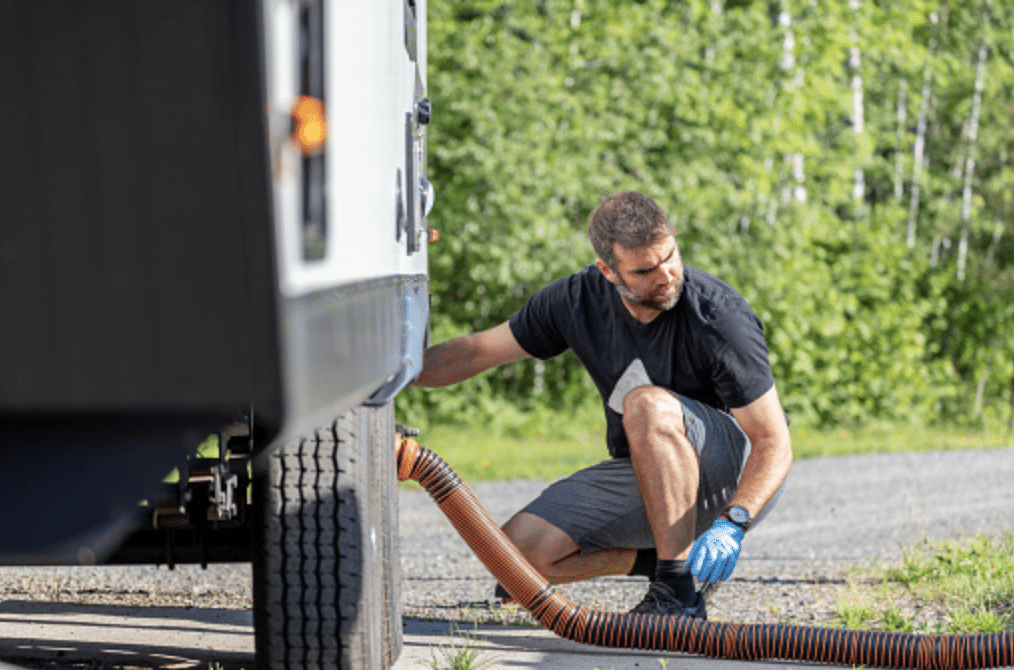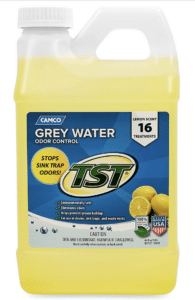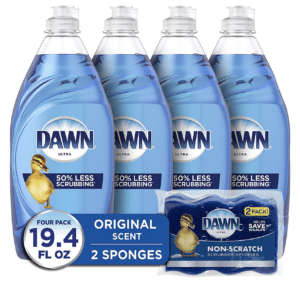
How well do you know your RV? Do you know where your holding tanks are? Can you tell the difference between your gray water tanks, your fresh water tank, and your black tank?
Feeling overwhelmed? We’ve been there! In this post, we’ll go over what grey water tanks are, what the difference between a gray tank and black tank is, maintenance tips for your grey water tank, and more!
Keep reading to learn all about the basics of what grey water is, how it differs from black water, and how you can properly maintain your own RV’s gray water tank!
Table of Contents
- What is Grey Water in an RV?
- Grey Water vs Black Water
- How to Empty Your RV Grey Water Tank
- Grey Water Tank Treatment & Maintenance
What is Grey Water in an RV?
To put it simply, grey water is any and all water that’s been used in your RV, but hasn’t gone through the RV toilet. This includes shower water, water from bathroom sinks (as well as the kitchen sink), and washing machines.
This water is stored in your grey water tank until you find a designated dumping station (more on that later).
Some recreational vehicles (such as Class A RVs and fifth wheels) have two grey water tanks.
Curious on how your RV gray water tank differs from your freshwater tank? Check out our guide on RV fresh water tanks here!
Grey Water vs Black Water
Grey water and black water are two different types of waste that come out of your RV.
Black water is the waste that comes from your RV toilet (we’re talking human waste and dirty water), while grey water is everything else.
Typically, you’re able to dump (drain) both your black tank as well as your gray tank at a dump station. So long as you’re careful to avoid contaminating any water sources, you’re good to go.
How exactly do you dispose of gray water when the tank is full?
Related Post — RV Electricity Basics: A Guide to Powering Your Rig
How to Empty Your RV Grey Water Tank
Have you noticed that the kitchen sink in your RV has a bit of water that won’t go down? Maybe the toilet bowl has a bit more water than usual? That means your tank is full and you need to find a dump station to drain the holding tanks!
Some truck stops have RV dump stations, but if you’re unsure where/how to look for these places, check out this map of RV dump stations!
Before anything, we highly recommend draining your black tank first. This way, if there’s any leftover waste water from the black tank in the sewer hose, the grey water will wash it away.
Pro Tip: We recommend using an RV sewer hose support while draining your tanks.

Alright, now that we have those steps out of the way, it’s time to get into the nitty gritty.
- Make sure to put rubber gloves on. No matter how careful you are, you could be splashed with grey or black water.
- Remove the caps covering the holding tank and connect your sewer hose.
- Place your sewer hose in the dump hole and secure it in place. If the hose won’t tighten all the way, lay something heavy on top of it to firmly keep it in place (such as a brick or a bucket).
- Open the black water tank valve and empty. When the black water is finished draining, open the grey water valve and drain.
- Once both RV tanks are drained, refill them with water and drain again.
- Close each valve and disconnect your sewer hose from the outlet. Remove the hose from the dump hole as well (be sure you get all of the water out and rinse it thoroughly if you notice any foul odors).
- Cover the dump hole and store your sewer hose away.
While you don’t have to do it every time you drain your RV tanks, we highly recommend cleaning your RV’s grey water tank every so often to keep foul odors away.
Important Note: Please make sure you don’t just dump grey water into some bushes or a random field as it’s illegal (not to mention, disrespectful and gross). The food particles left in the grey water tank from sink water and any/all chemical products you use to clean your sinks and shower drains all sit in the grey water tank until it’s emptied. What you’re left with is dirty water with a foul odor (something that no one wants to smell).
Related Post — Best RV Water Filters in 2023 (Review & Buyer’s Guide)
Grey Water Tank Treatment & Maintenance
After your grey water tank has been emptied, you’ll want to give it a good cleaning. If you want to take the lazy route, after you empty your holding tanks at an RV dump station, fill the grey water tank halfway with water and add your cleaning solution.
As you drive away, the water and cleaning solution will slosh around in the holding tank which ends up saving you a few hours of scrubbing!
There are several products out there, but we recommend using products like:
Thetford Blaster Holding Tank Cleaner
- The first 2-in-1 tank cleaner specifically formulated for black/gray water and portable tanks
- Cleans overnight – then just dump and go
- Active enzymatic blend blasts crud and attacks tissue, waste, and grease

Camco Grey Water Odor Control
- Remove grease buildup in your gray water system
- 64 oz bottle, 4 ounces treats 40 gallon gray water tank
- Eliminates odors

Dawn Dish Soap
- Contains 3x Grease Cleaning Power (cleaning ingredients per drop vs. Dawn Non-Concentrated)
- Contains biodegradable surfactants
- Phosphate-Free

Important: We don’t recommend using bleach. It can damage your RV’s seals and gaskets as well as kill bacteria needed to help break down waste.
As long as you give your RV grey tank the proper maintenance, you’ll be good to go.
Let us know in the comments below what method you use to clean your RV’s grey water tank!
Read Next:
- A Complete List of RV Manufacturers
- How to Keep Mice Out Of Your Camper
- How to Keep Your RV Cool in the Summer
- 50+ Best RV Accessories, Gadgets, & Fun Toys
- 10 Fun Road Trip Games to Play On Your RV Vacation
- 7 Best RV Tankless Water Heaters for On-Demand Hot Water
- The 5 Best RV Sewer Hoses (That Won’t Leak On You)




